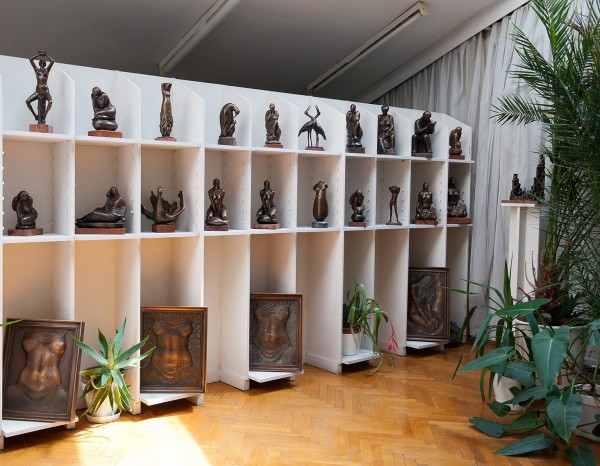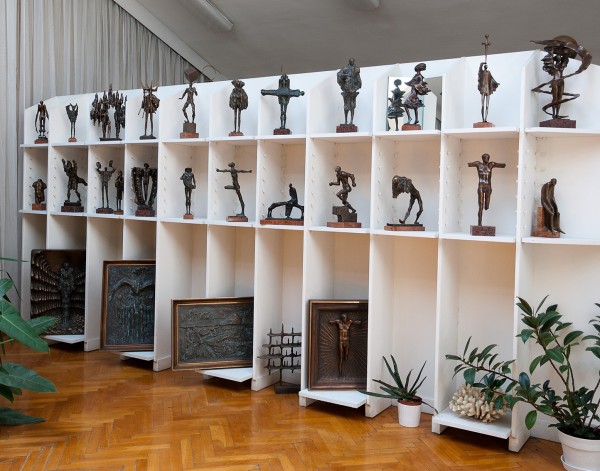Conversation about sculpture
„Works of the past years can be
considered as a diary”
Interview with the Sculptor Gusztáv Pálfy (extract)
I looked at your exhibition catalogues and found that you have worked in every field of sculpture. Why is it that yet you only concentrated on the statuettes in your catalogue?
Although I made some significant statues for public places, I feel the statuette closest to me. This genre gives much freedom in sculpture and has many potentialities in it to effectively express exciting messages in the language of form. My small bronzes deal with the uplifting events of human life and inquire about creation, birth, death, the relationship between men and women, the connection between man and nature. I could also often use this genre to reflect on the most significant impressions I had. Works of the past years can be considered as a diary with each page containing a sculpture cast on the basis of an important thought.

Before casting your statuettes do you have a vision of the future sculpture? Do you change or modify your original idea while working with the given material?
When working according to a conscious composition, I always see with my mind’s eye what I am going to create. However, no statuette can ever be the same as my virtual image of it. It will always turn out to be different because I correct the accidents and build new ideas into the composition throughout the process of creation.
Your oeuvre contains more versions of the same work sometimes. Why is it important for you to create versions of the same work in different styles?
I have a number of themes that I find significant enough to be rearticulated. In case f the “Mourner” for instance I had the expressive and passionate version first and years later I wished to achieve with simpler means a statuette that would have a more intensified aesthetic, intellectual and emotional air around it. The dead figure is negative while the living one is represented as a positive figure. I emphasized the feeling of pain through making edges, pointed tips and negative surfaces.
Whenever I meet your sculptures either at an exhibition or here in your studio I always seem to discover that they are different in style. Could you define traits of the trends represented by your statuettes or, as you call them, works?
There have been great changes going on in our society as well as in art over the past fifty years. A twenty-year-old lad thinks in a different way from that of a seventy-yearold man and this difference in thinking accounts for the different representations. First I started with realist and lyrical bronze sculptures but then I turned towards the representation of the thinking man and this is how those sculptures were born which seek answers for the real questions of life. Then I could get to simpler forms with a more mature system of proportion. Nowadays, my works are characterized by more and more abstract representation but I do hope that even my abstract statues are still comprehensible.

You mentioned the significance of emotional, intellectual and social effects working together to form the style of a statuette. Can you give examples?
It was long ago that I became conscious of the process of ruining our environment and this made me work on a thematic series, which I termed “sculptures expressing my anxiety over the environment”. These works are characterized by a hyperrealist representation of critical situations. I have a number of funny statuettes as well. I find grotesque an effective form of representation if it can criticize with a positive intention and passion at the same time.
In what way have criticisms of the exhibitions influenced your work?
Both praises and negative criticisms were of use as for me. However, I tried to be cautious about indulging in praises. I profited a lot from the criticisms of Mária Egri, Dr Anna Oelmacher Mrs Endre Ury, Gábor Pogány Ö., Béla Újvári, Tibor Wehner,
Pál Szuromi and others.
What future plans are you thinking about for sculpture?
I expressed the most essential things about human relations in my small bronzes. For three years now I have been working on themes suitable for reliefs. I have not had any opportunities yet to work on the horse as my favourite theme. To gain real insight, I “learnt the horse” for two years. This work helps me forget what I am really missing: the surrounding world being more interested in art and sculpture within.
The tendency to mistreat our environment has been strengthening for a while. Consequently, I have decided that through my works and thematic exhibitions I can draw attention to the importance of protecting our environment.
Márta Daróczi Kiss (Köztér)